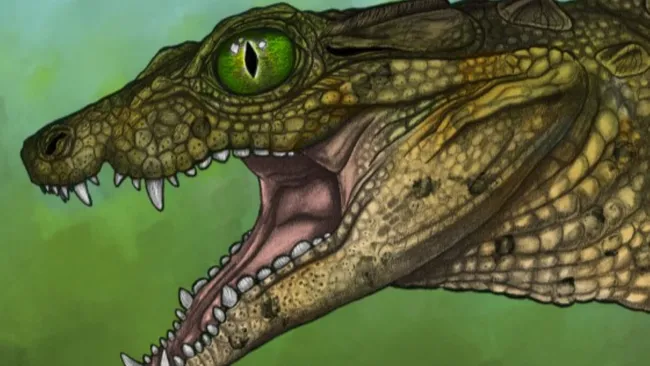BOZEMAN, Montana – About 95 million years ago, a tiny crocodyliform nicknamed “Elton” roamed what is now southwest Montana, near the edge of the Western Interior Seaway.
Measuring no more than two feet from snout to tail, young Elton was roughly the size of a large lizard. Had it reached adulthood, it would have topped out at just three feet—far smaller than most members of the Neosuchia clade, which includes modern crocodiles and their extinct relatives. Unlike its mostly aquatic cousins with simple conical teeth, Elton lived on land and likely ate a mix of plants, insects, and small animals. Its distinctive teeth and skeletal features reveal it belonged to a previously unrecognized family of terrestrial crocodyliforms endemic to Cretaceous North America.
The discovery was the result of sharp eyes and keen curiosity. In the summer of 2021, Harrison Allen, then an undergraduate in Montana State University’s field paleontology course, noticed a tiny fossil with an unusual texture while digging in the Blackleaf Formation near Dillon. “I knew it had to be something special,” Allen recalled. He brought it to professor David Varricchio, who immediately recognized the specimen’s potential.
After years of careful excavation, study, and digital reconstruction, Allen and his colleagues published a paper this week in the Journal of Vertebrate Paleontology describing the new species, Thikarisuchus xenodentes, named for its peculiar sheathed teeth. The specimen includes fragments from nearly every part of the body, including a 50-millimeter-long skull. To preserve the delicate bones, Allen and his fellow students relied on CT scans and painstakingly colored digital slices to distinguish fossil from rock.
Working on Elton became a transformative experience for Allen. He spent hours sifting sediment and reconstructing the skeleton, eventually learning that the fossil was likely preserved in a burrow, consistent with other specimens from the Blackleaf and Wayan Formations.
The study also provides insight into crocodyliform evolution. Thikarisuchus belongs to the newly named family Wannchampsidae, a group of small, terrestrial crocs. Similar features have been found in Eurasian Atopasauridae, suggesting convergent evolution in distant continents driven by comparable environments and prey availability.
For Allen, the experience cemented his passion for paleontology. “The diversity of ancient crocs amazes me—marine, terrestrial, herbivorous, omnivorous, shell-cracking. It’s incredible,” he said. Varricchio added, “Harrison’s enthusiasm and dedication made him a joy to mentor. Discoveries like Elton remind us how much we can still learn from these ancient creatures.”
